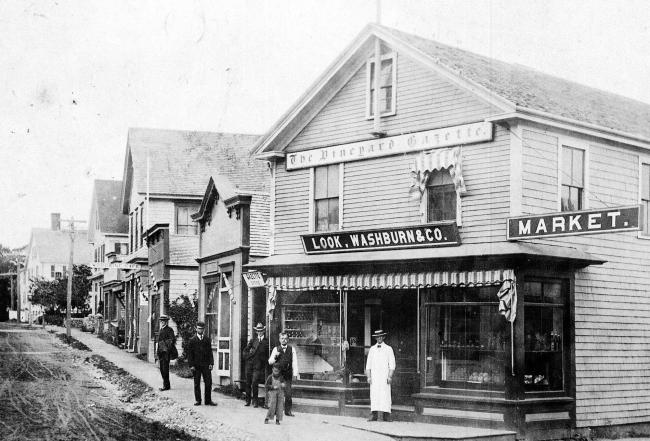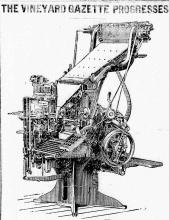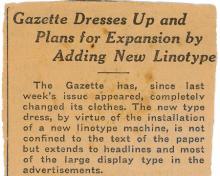A new Linotype bearing the technical name of Blue Streak Master Model 31 was erected in the office of the Vineyard Gazette last week, a mechanical marvel whose weight of a little more than two tons is helping to keep the maple flooring from warping. As indicated last week it got into production in time to help out with the Jan. 7 edition.
The effect of the latest installation in the back office will make little difference in the physical appearance of the Gazette; its benefit is intended to ease the composition load of the black gang, especially in advertising typesetting. This aid is implemented by a number of new devices which have been developed since the last previous line-composing machine was purchased.
To mention one of these, the most important, it must be understood that in keyboard operation of line-composing machines—as compared with typewriters—all spacing requires the manual manipulation of keys. What you don’t see, in other words, has had to be set. All clear?
Helps Out in Unseen Labor
Well, to help out in this unseen labor, there has come along a device known as a self-quadder (quad means space) which produces some phases of the spacing operation automatically. To illustrate the time saving, three examples, employing a time-honored keyboard phrase, are presented:
etaoin
etaoin
etaoin
A look at the first line shows that it is indented, or quadded, to the left. The important point, however, from the machine operator’s seat, is that all the white space was cast automatically, by the flip of a handle. The second line, centered, was also automatically accomplished, as to spacing and position, by a lever, and as before only the letters are the response of keyboard operation. Readers will guess how the third line came about; no use in giving away everything.
The process may be duplicated any length of line—up to thirty picas, which is near enough to five inches to stop an argument—and in all sizes of types available on the machine. Look at the advertisements, try to visualize what is done by a flip, and you’ll get the idea.
The self-quadding accessory has been on the market for some time, although it has been considered reliable a comparatively short time. Its mechanism involves a great many extra parts, all precision made. Some of its screws are inserted by tweezers, and one part has a tolerance of one-thousandth of an inch, which is getting into the watch class. All this gives rise to wonder what a stray molten metal splash or chip might do.
Two Years for Delivery
The machine was ordered in December of 1946, and delivered in November of 1948—but everyone who has waited for an automobile knows about that. They know, too, of price differences. The new Linotype cost just about ninety-five per cent more than the one it replaced, and there was some breath-holding hereabouts at successive price rises between the dates of order and delivery.
The replaced machine, installed in 1927, is numbered 41891; the new one is 60879—figures showing that Linotypes are not as many as automobiles. Wouldn’t you think there’d be more, though?
No. 41891 has had a busy time in its twenty-two years in the Gazette office, and although displaced here, its end is by no means yet. It was bought at the weekend by a New York dealer—one of a couple of dozen interested—who intends to rebuild it. He has a customer too: it is destined to set Arabic in the Palestine area. What a place to call Brooklyn for parts from.









Comments